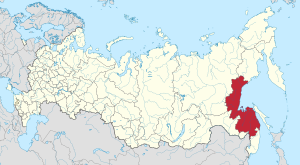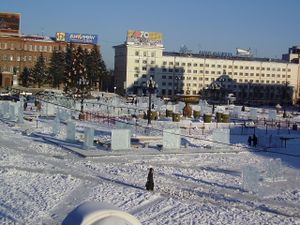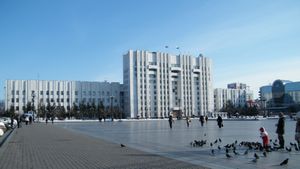كراي خبروڤسك
Khabarovsk Krai | |
|---|---|
| Хабаровский край | |
| النشيد: [1] | |
 | |
| الإحداثيات: 54°48′N 136°50′E / 54.800°N 136.833°ECoordinates: 54°48′N 136°50′E / 54.800°N 136.833°E | |
| البلد | روسيا |
| المنطقة الاتحادية | الشرق الأقصى[2] |
| المنطقة الاقتصادية | الشرق الأقصى[3] |
| تأسست | 20 October 1938[4] |
| المركز الاداري | خبروڤسك |
| الحكومة | |
| • الكيان | Legislative Duma[5] |
| • Governor[5] | Yuri Zolochevsky (acting) |
| المساحة | |
| • Total | 788٬600 كم² (304٬500 ميل²) |
| ترتيب المساحة | 4th |
| التعداد (2010 Census)[7] | |
| • Total | 1٬343٬869 |
| • Estimate (2018) | 1٬328٬302 (−1٫2%) |
| • الترتيب | 34th |
| • الكثافة | 1٫7/km2 (4٫4/sq mi) |
| • Urban | 81٫8% |
| • الريف | 18٫2% |
| منطقة التوقيت | UTC+10 (توقيت فلاديفوستوك |
| ISO 3166 code | RU-KHA |
| لوحات السيارات | 27 |
| OKTMO ID | 08000000 |
| اللغات الرسمية | الروسية[9] |
| الموقع الإلكتروني | http://www.khabkrai.ru |
كراي خبروڤسك (روسية: Хаба́ровский край, النطق خبروڤسكي كراي; النطق الروسي: [xɐˈbarəfskʲɪj kraj]) هي إحدى الكيانات الفدرالية في روسيا. ويقع جغرافياً في الشرق الأقصى الروسي وهو جزء من منطقة الشرق الأقصى الاتحادية. المركز الاداري للكراي هو مدينة خبروڤسك، التي تضم نحو نصف سكان الكراي وهي أكبر مدن الشرق الأقصى الروسي (أكبر من ڤلاديڤوستوك). وكراي خبروڤسك هو رابع أكبر كيان فدرالي من حيث المساخة، بتعداد 1,343,869 نسمة، في (2010 Census).[7]
يقع معظم المنطقة الجنوبية في حوض نهر الآمور السفلي، ويقع مصب النهر عند نيقولايڤسك على الآمور مُصرِّفاً مياهه في مضيق تارتاري, which separates Khabarovsk Krai from the island of Sakhalin. The north occupies a vast mountainous area along the coastline of the Sea of Okhotsk, a marginal sea of the Pacific Ocean. Khabarovsk Krai is bordered by Magadan Oblast to the north, Amur Oblast, Jewish Autonomous Oblast and the Sakha Republic to the west, Primorsky Krai to the south, and Sakhalin Oblast to the east.
The population is mostly ethnic Russians, but indigenous people of the area are various Tungusic peoples (Evenks, Negidals, Ulchs, Nanai, Oroch, Udege) and Amur Nivkhs and Ainu.[10]
. . . . . . . . . . . . . . . . . . . . . . . . . . . . . . . . . . . . . . . . . . . . . . . . . . . . . . . . . . . . . . . . . . . . . . . . . . . . . . . . . . . . . . . . . . . . . . . . . . . . . . . . . . . . . . . . . . . . . . . . . . . . . . . . . . . . . . . . . . . . . . . . . . . . . . . . . . . . . . . . . . . . . . . .
الجغرافيا
Khabarovsk Krai shares its borders with Magadan Oblast in the north, with the Sakha Republic and Amur Oblast in the west, with the Jewish Autonomous Oblast, China (Heilongjiang), and Primorsky Krai in the south, and is limited by the Sea of Okhotsk in the east. In terms of area, it is the fourth-largest federal subject within Russia. Major islands include Shantar Islands.
Taiga and tundra in the north, swampy forest in the central depression, and deciduous forest in the south are the natural vegetation in the area.
التاريخ
According to various Chinese and Korean records, the southern part of Khabarovsk Krai was originally occupied by one of the five semi-nomadic Shiwei, the Bo Shiwei tribes and the Black Water Mohe tribes living respectively on the west and the east of the Bureya and the Lesser Khingan ranges.
In 1643, Vassili Poyarkov's boats descended the Amur, returning to Yakutsk by the Sea of Okhotsk and the Aldan River, and in 1649–1650 Yerofey Khabarov occupied the banks of the Amur. The resistance of the Chinese, however, obliged the Cossacks to quit their forts, and by the Treaty of Nerchinsk (1689) Russia abandoned her advance into the basin of the river.
Although the Russians were thus deprived of the right to navigate the Amur River, the territorial claim over the lower courses of the river was not settled in the Treaty of Nerchinsk of 1689. The area between Uda River and Greater Khingan mountain range (i.e. most of Lower Amuria) was left undemarcated and the Sino-Russian border was allowed to fluctuate.[11][12]
Later in the nineteenth century, Nikolay Muravyov would conduct an aggressive policy with China by claiming that the lower reaches of the Amur River belonged to Russia. In 1852, a Russian military expedition under Muravyov explored the Amur, and by 1857 a chain of Russian Cossacks and peasants had been settled along the whole course of the river. In 1858, in the Treaty of Aigun, China recognized the Amur River downstream as far as the Ussuri River as the boundary between Russia and the Qing Empire, and granted Russia free access to the Pacific Ocean.[13] The Sino-Russian border was later further delineated in the Treaty of Peking of 1860 when the Ussuri Territory (the Maritime Territory), which was previously a joint possession, became Russian.[14]
Modern Khabarovsk Krai was established on 20 October 1938, when the Far Eastern Krai was split into the Khabarovsk and Primorsky Krais.[4] On 24 April 1996 Khabarovsk signed a power-sharing agreement with the federal government, granting it autonomy.[15] This agreement would be abolished on 12 August 2002.[16]
القسيمات الادارية
السياسة
Economy
Khabarovsk Krai is the most industrialized territory of the Far East of Russia, producing 30% of the total industrial products in the Far Eastern Economic Region.
Heavy industry
The machine construction industry consists primarily of a highly developed military-industrial complex of large-scale aircraft- and shipbuilding enterprises.[17] The Komsomolsk-on-Amur Aircraft Production Association is currently among the krai's most successful enterprises, and for years has been the largest taxpayer of the territory.[17] Other major industries include timber-working and fishing, along with metallurgy in the main cities. Komsomolsk-on-Amur is the iron and steel centre of the Far East; a pipeline from northern Sakhalin supplies the petroleum-refining industry in the city of Khabarovsk. In the Amur basin, there is also some cultivation of wheat and soybeans. The administrative centre, Khabarovsk, is at the junction of the Amur River and the Trans-Siberian Railway.
Mining
The region's own mineral resources are underdeveloped. The region hosts large Gold mining operations (Highland Gold, Polus Gold), a major but low-grade Copper deposit being explored by IG Integro Group and a world-class tin district which was a major contributor to the Soviet Industrial complex and is currently being revitalised by Far Eastern Tin (Festivalnoye mine) and by Sable Tin Resources which is developing the Sable Tin Deposit (Sobolinoye) large high grade deposit, 25 km from Solnechny town.
الديمغرافيا

Population: 1,343,869 (تعداد 2010);[7] 1,436,570 (تعداد 2002);[18] 1,824,506 (تعداد 1989).[19]
According to the 2010 Census,[7] 91.8% of the population are Russians, 2.1% Ukrainians, 0.8% Nanais, 0.6% Tatars, 0.6% Koreans, and 0.4% Belarusians. 55,038 people were registered from administrative databases, and could not declare an ethnicity. It is estimated that the proportion of ethnicities in this group is the same as that of the declared group.[20]
In addition to the Nanai, other indigenous groups include the Evenks and Evens in the northern part of the province, and Ulchs in the lower Amur river (Ulchsky District). Some Nivkhs (Gilyak), an indigenous fishing people speaking an isolate language, live around the Amur river delta as well. Smaller groups indigenous to the area are Negidals (567), Orochs (686), and Udege (1,657) and Taz people (3) according to the 2002 census.
- Births (2009): 17,573 (12.5 per 1000)
- Deaths (2009): 19,115 (13.6 per 1000)[21]
- Urban Births (2009): 13,612 (12.1 per 1000)
- Rural Births (2009): 3,961 (14.5 per 1000)
- Urban Deaths (2009): 15,472 (13.7 per 1000)
- Rural Deaths (2009): 3,643 (13.3 per 1000)[22]
The birth rate for 2008 is 5.2% higher than that in 2007, and the death rate is 1.4% lower. Birth rate was recorded at 11.6 for 2007 (11.1 for Urban areas and 13.8 for Rural areas) per 1000 people. The death rate was 14.2 in 2007 (14.3 for Urban areas and 14.0 for Rural areas). Rural locations of Khabarovsk Krai had a positive natural growth of population in 2008 (for the first time in the last 16 years).[22]
التجمعات السكنية
أكبر المدن أو البلدات في Khabarovsk Krai
2010 Russian Census | |||||||||
|---|---|---|---|---|---|---|---|---|---|
| الترتيب | Administrative Division | التعداد | |||||||
| Komsomolsk-on-Amur Komsomolsk-on-Amur |
1 | Khabarovsk | Khabarovsky District | 577,441 |  Amursk  Nikolayevsk-on-Amur | ||||
| 2 | Komsomolsk-on-Amur | Komsomolsky District | 263,906 | ||||||
| 3 | Amursk | Amursky District | 42,970 | ||||||
| 4 | Nikolayevsk-on-Amur | Nikolayevsky District | 22,752 | ||||||
| 5 | Sovetskaya Gavan | Sovetsko-Gavansky District | 27,712 | ||||||
| 6 | Bikin | Bikinsky District | 17,154 | ||||||
| 7 | Vanino | Vaninsky District | 17,001 | ||||||
| 8 | Vyazemsky | Vyazemsky District | 14,555 | ||||||
| 9 | Solnechny | Solnechny District | 13,306 | ||||||
| 10 | Chegdomyn | Verkhnebureinsky District | 13,048 | ||||||
- Vital statistics for 2012
- Births: 18 324 (13.6 per 1000)
- Deaths: 18 169 (13.5 per 1000) [23]
Total fertility rate:[24]
2009 – 1.59 | 2010 – 1.56 | 2011 – 1.57 | 2012 – 1.70 | 2013 – 1.74 | 2014 – 1.79 | 2015 – 1.85 | 2016 – 1.79(e)
وتحوي المدن والقرى التالية: أمورسك، بيكين، خبروڤسك، كومسومولسك-نا-أموري، نيكولايفسك-نا-أمور، سوفتسكايا گافان، فيازيمسكي،
. . . . . . . . . . . . . . . . . . . . . . . . . . . . . . . . . . . . . . . . . . . . . . . . . . . . . . . . . . . . . . . . . . . . . . . . . . . . . . . . . . . . . . . . . . . . . . . . . . . . . . . . . . . . . . . . . . . . . . . . . . . . . . . . . . . . . . . . . . . . . . . . . . . . . . . . . . . . . . . . . . . . . . . .
الدين
According to a 2012 survey,[25] 26.2% of the population of Khabarovsk Krai adheres to the Russian Orthodox Church, 4% are unaffiliated generic Christians, 1% adheres to other Orthodox churches or is a believer in Orthodox Christianity who doesn't belong to any church, 1% is an adherent of Islam. In addition, 28% of the population declares to be "spiritual but not religious", 23% is atheist, and 16.8% follows other religions or did not give an answer to the question.[25]
الهامش
|
المصادر
- Хабаровская краевая Дума. №150 30 ноября 1995 г. «Устав Хабаровского края», в ред. Закона №202 от 30 июля 2008 г. (Khabarovsk Krai Duma. #150 November 30, 1995 Charter of Khabarovsk Krai, as amended by the Law #202 of July 30, 2008).
- Chaussonnet, Valerie (1995) Native Cultures of Alaska and Siberia. Arctic Studies Center. Washington, D.C. 112p. ISBN 1560986611
وصلات خارجية
 Media related to كراي خبروڤسك at Wikimedia Commons
Media related to كراي خبروڤسك at Wikimedia Commons- (إنگليزية)Informations concerning the Shiwei tribes and their relationship with the Khitans
- (بالروسية) Brief history of Khabaovsk Krai
- Articles containing روسية-language text
- CS1 الروسية-language sources (ru)
- CS1 errors: unsupported parameter
- CS1 errors: URL–wikilink conflict
- CS1 maint: numeric names: authors list
- CS1 errors: markup
- Articles with hatnote templates targeting a nonexistent page
- Short description is different from Wikidata
- Coordinates on Wikidata
- كرايات روسيا



